Technology Assisted Review (TAR) Applications in Legal Cases
VerifiedAdded on 2020/07/22
|9
|2576
|228
Report
AI Summary
This report delves into the application of Technology Assisted Review (TAR) in legal cases, focusing on its evolution, benefits, and limitations. It defines TAR as the integration of technology to streamline human document review, highlighting its use in predictive coding and e-discovery. The report examines the case of McConnell Dowell Constructors (Aust) Pty Ltd v Santam Ltd & Ors, where TAR was used to manage a large volume of electronic documents, saving time and costs. It also references Dotcom v United States of America, emphasizing the importance of efficient technology use in legal processes. The benefits of TAR, including time savings, cost reduction, and increased accuracy, are discussed, along with its conceptual search capabilities and communication advantages. The report also addresses the challenges of TAR, such as uncertainty in training time, applicability limitations, and the need for senior lawyer involvement. Finally, it explores the use of TAR in civil practices, emphasizing its role in managing large datasets and improving the efficiency of legal research, particularly in the Australian court system.
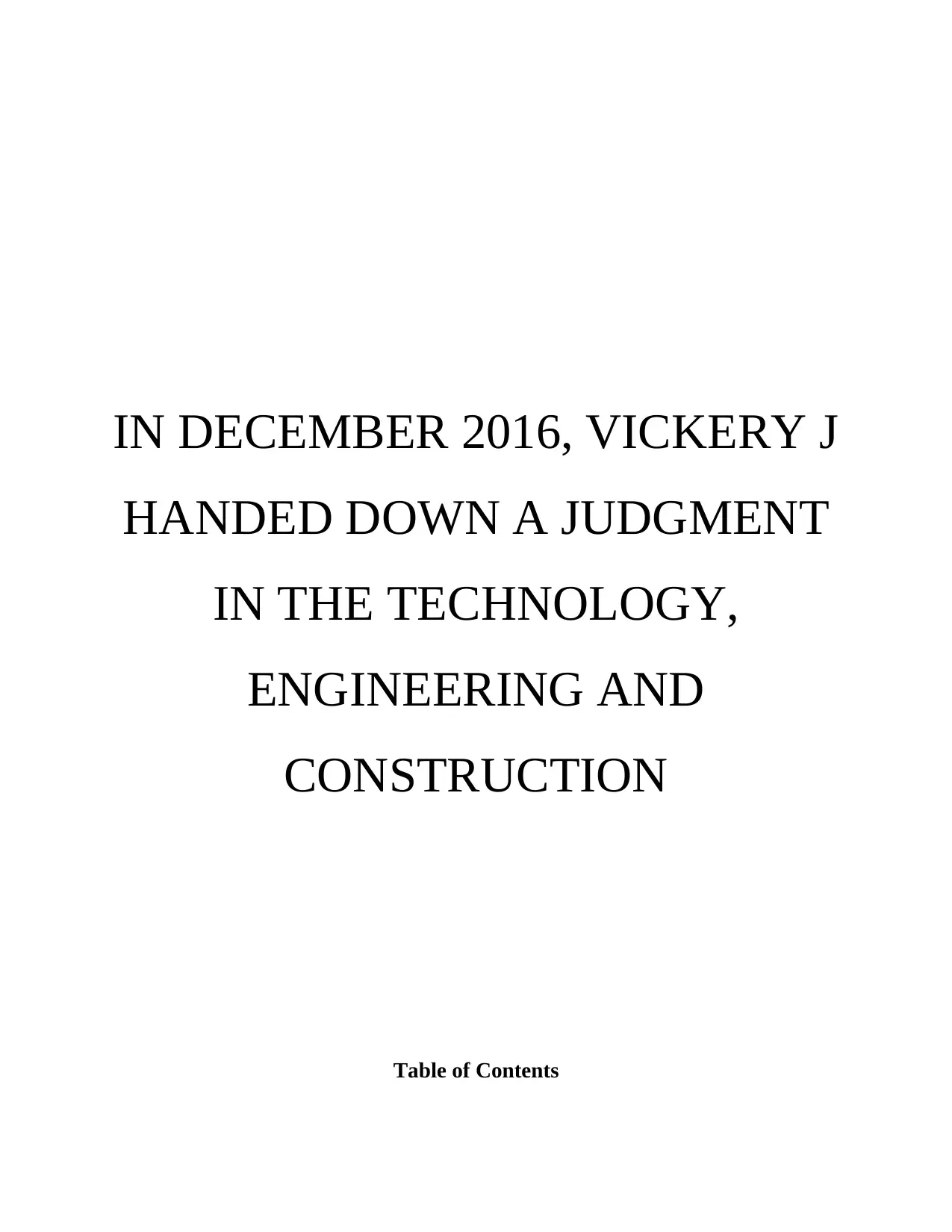
IN DECEMBER 2016, VICKERY J
HANDED DOWN A JUDGMENT
IN THE TECHNOLOGY,
ENGINEERING AND
CONSTRUCTION
Table of Contents
HANDED DOWN A JUDGMENT
IN THE TECHNOLOGY,
ENGINEERING AND
CONSTRUCTION
Table of Contents
Paraphrase This Document
Need a fresh take? Get an instant paraphrase of this document with our AI Paraphraser

INTRODUCTION...........................................................................................................................1
TASK...............................................................................................................................................1
CONCLUSION................................................................................................................................5
REFERENCES................................................................................................................................6
TASK...............................................................................................................................................1
CONCLUSION................................................................................................................................5
REFERENCES................................................................................................................................6

⊘ This is a preview!⊘
Do you want full access?
Subscribe today to unlock all pages.

Trusted by 1+ million students worldwide
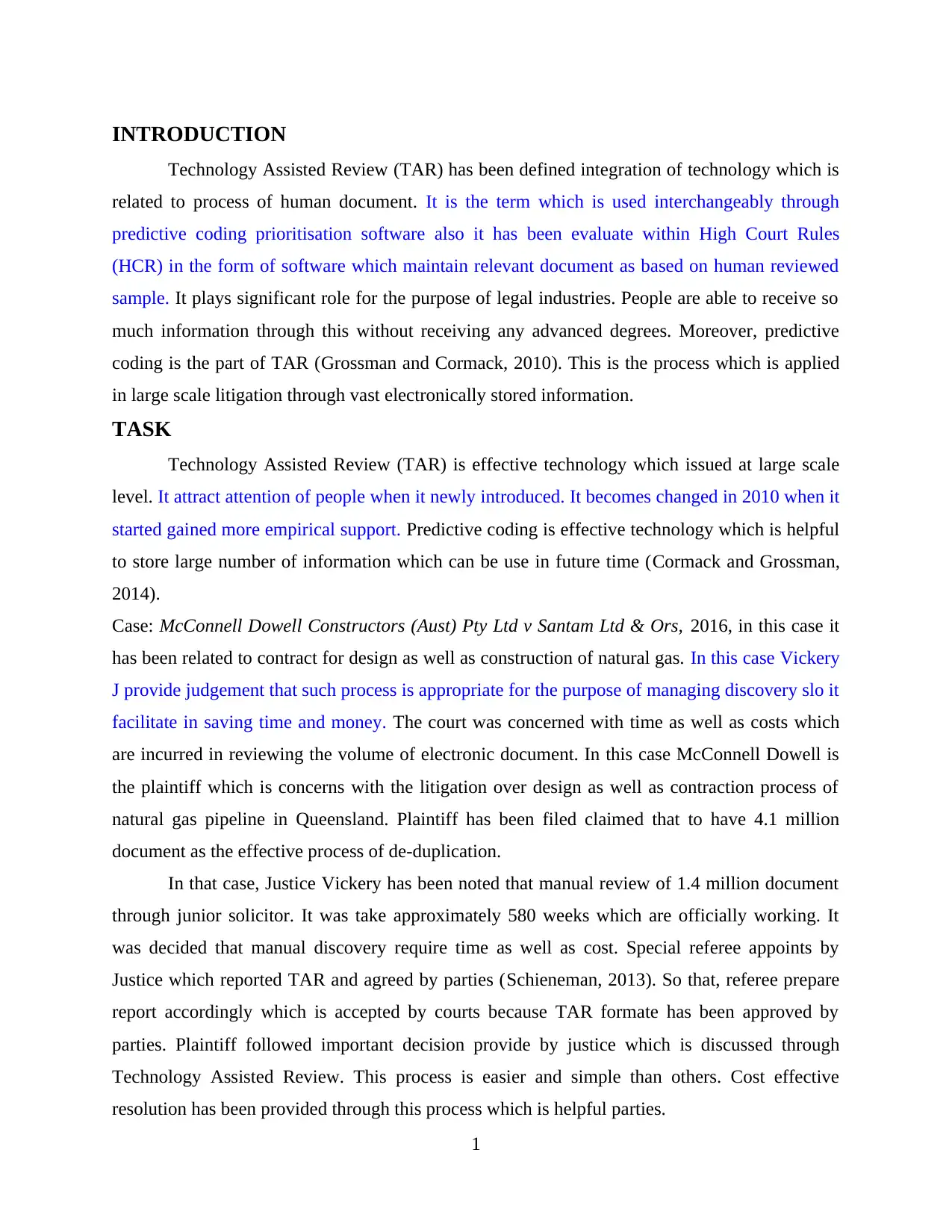
INTRODUCTION
Technology Assisted Review (TAR) has been defined integration of technology which is
related to process of human document. It is the term which is used interchangeably through
predictive coding prioritisation software also it has been evaluate within High Court Rules
(HCR) in the form of software which maintain relevant document as based on human reviewed
sample. It plays significant role for the purpose of legal industries. People are able to receive so
much information through this without receiving any advanced degrees. Moreover, predictive
coding is the part of TAR (Grossman and Cormack, 2010). This is the process which is applied
in large scale litigation through vast electronically stored information.
TASK
Technology Assisted Review (TAR) is effective technology which issued at large scale
level. It attract attention of people when it newly introduced. It becomes changed in 2010 when it
started gained more empirical support. Predictive coding is effective technology which is helpful
to store large number of information which can be use in future time (Cormack and Grossman,
2014).
Case: McConnell Dowell Constructors (Aust) Pty Ltd v Santam Ltd & Ors, 2016, in this case it
has been related to contract for design as well as construction of natural gas. In this case Vickery
J provide judgement that such process is appropriate for the purpose of managing discovery slo it
facilitate in saving time and money. The court was concerned with time as well as costs which
are incurred in reviewing the volume of electronic document. In this case McConnell Dowell is
the plaintiff which is concerns with the litigation over design as well as contraction process of
natural gas pipeline in Queensland. Plaintiff has been filed claimed that to have 4.1 million
document as the effective process of de-duplication.
In that case, Justice Vickery has been noted that manual review of 1.4 million document
through junior solicitor. It was take approximately 580 weeks which are officially working. It
was decided that manual discovery require time as well as cost. Special referee appoints by
Justice which reported TAR and agreed by parties (Schieneman, 2013). So that, referee prepare
report accordingly which is accepted by courts because TAR formate has been approved by
parties. Plaintiff followed important decision provide by justice which is discussed through
Technology Assisted Review. This process is easier and simple than others. Cost effective
resolution has been provided through this process which is helpful parties.
1
Technology Assisted Review (TAR) has been defined integration of technology which is
related to process of human document. It is the term which is used interchangeably through
predictive coding prioritisation software also it has been evaluate within High Court Rules
(HCR) in the form of software which maintain relevant document as based on human reviewed
sample. It plays significant role for the purpose of legal industries. People are able to receive so
much information through this without receiving any advanced degrees. Moreover, predictive
coding is the part of TAR (Grossman and Cormack, 2010). This is the process which is applied
in large scale litigation through vast electronically stored information.
TASK
Technology Assisted Review (TAR) is effective technology which issued at large scale
level. It attract attention of people when it newly introduced. It becomes changed in 2010 when it
started gained more empirical support. Predictive coding is effective technology which is helpful
to store large number of information which can be use in future time (Cormack and Grossman,
2014).
Case: McConnell Dowell Constructors (Aust) Pty Ltd v Santam Ltd & Ors, 2016, in this case it
has been related to contract for design as well as construction of natural gas. In this case Vickery
J provide judgement that such process is appropriate for the purpose of managing discovery slo it
facilitate in saving time and money. The court was concerned with time as well as costs which
are incurred in reviewing the volume of electronic document. In this case McConnell Dowell is
the plaintiff which is concerns with the litigation over design as well as contraction process of
natural gas pipeline in Queensland. Plaintiff has been filed claimed that to have 4.1 million
document as the effective process of de-duplication.
In that case, Justice Vickery has been noted that manual review of 1.4 million document
through junior solicitor. It was take approximately 580 weeks which are officially working. It
was decided that manual discovery require time as well as cost. Special referee appoints by
Justice which reported TAR and agreed by parties (Schieneman, 2013). So that, referee prepare
report accordingly which is accepted by courts because TAR formate has been approved by
parties. Plaintiff followed important decision provide by justice which is discussed through
Technology Assisted Review. This process is easier and simple than others. Cost effective
resolution has been provided through this process which is helpful parties.
1
Paraphrase This Document
Need a fresh take? Get an instant paraphrase of this document with our AI Paraphraser
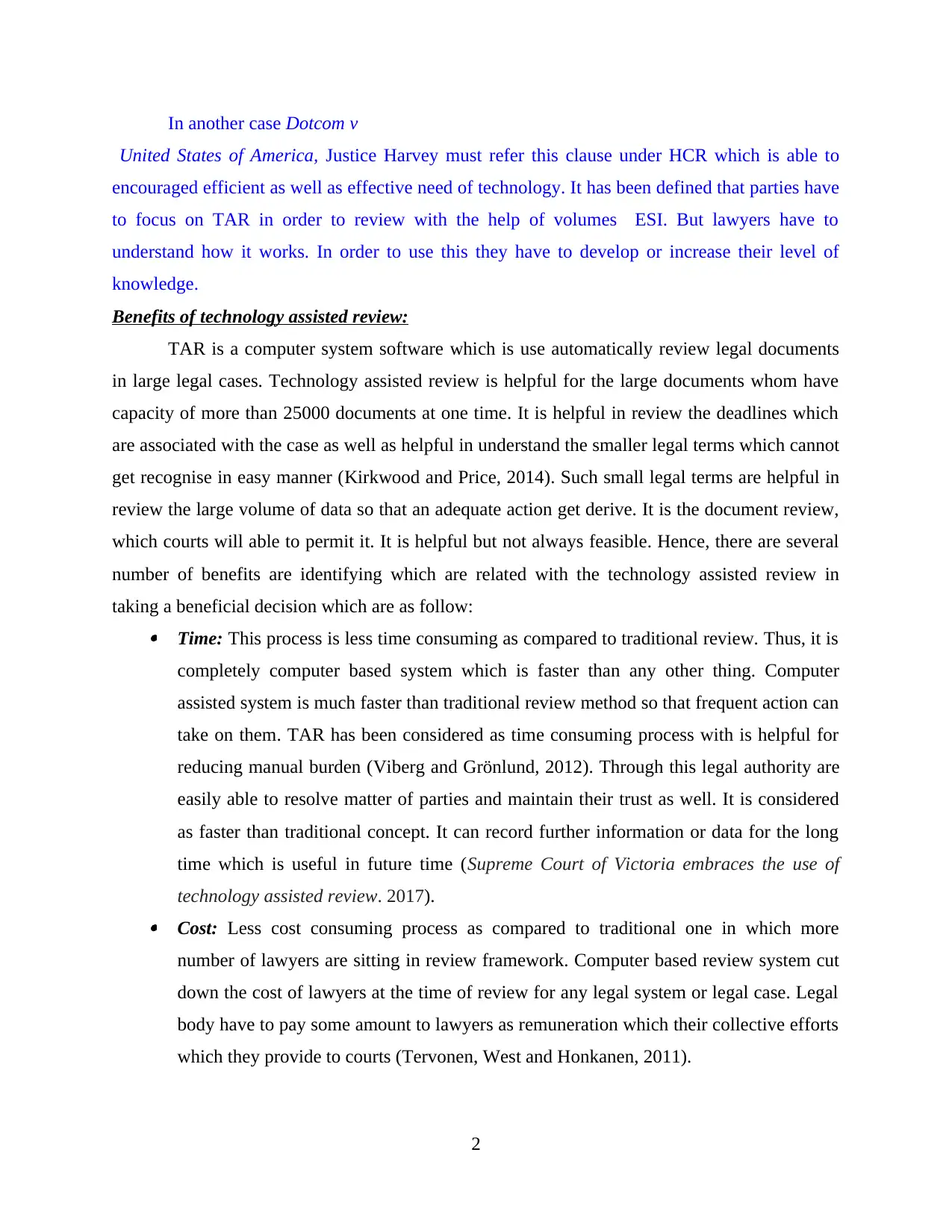
In another case Dotcom v
United States of America, Justice Harvey must refer this clause under HCR which is able to
encouraged efficient as well as effective need of technology. It has been defined that parties have
to focus on TAR in order to review with the help of volumes ESI. But lawyers have to
understand how it works. In order to use this they have to develop or increase their level of
knowledge.
Benefits of technology assisted review:
TAR is a computer system software which is use automatically review legal documents
in large legal cases. Technology assisted review is helpful for the large documents whom have
capacity of more than 25000 documents at one time. It is helpful in review the deadlines which
are associated with the case as well as helpful in understand the smaller legal terms which cannot
get recognise in easy manner (Kirkwood and Price, 2014). Such small legal terms are helpful in
review the large volume of data so that an adequate action get derive. It is the document review,
which courts will able to permit it. It is helpful but not always feasible. Hence, there are several
number of benefits are identifying which are related with the technology assisted review in
taking a beneficial decision which are as follow: Time: This process is less time consuming as compared to traditional review. Thus, it is
completely computer based system which is faster than any other thing. Computer
assisted system is much faster than traditional review method so that frequent action can
take on them. TAR has been considered as time consuming process with is helpful for
reducing manual burden (Viberg and Grönlund, 2012). Through this legal authority are
easily able to resolve matter of parties and maintain their trust as well. It is considered
as faster than traditional concept. It can record further information or data for the long
time which is useful in future time (Supreme Court of Victoria embraces the use of
technology assisted review. 2017). Cost: Less cost consuming process as compared to traditional one in which more
number of lawyers are sitting in review framework. Computer based review system cut
down the cost of lawyers at the time of review for any legal system or legal case. Legal
body have to pay some amount to lawyers as remuneration which their collective efforts
which they provide to courts (Tervonen, West and Honkanen, 2011).
2
United States of America, Justice Harvey must refer this clause under HCR which is able to
encouraged efficient as well as effective need of technology. It has been defined that parties have
to focus on TAR in order to review with the help of volumes ESI. But lawyers have to
understand how it works. In order to use this they have to develop or increase their level of
knowledge.
Benefits of technology assisted review:
TAR is a computer system software which is use automatically review legal documents
in large legal cases. Technology assisted review is helpful for the large documents whom have
capacity of more than 25000 documents at one time. It is helpful in review the deadlines which
are associated with the case as well as helpful in understand the smaller legal terms which cannot
get recognise in easy manner (Kirkwood and Price, 2014). Such small legal terms are helpful in
review the large volume of data so that an adequate action get derive. It is the document review,
which courts will able to permit it. It is helpful but not always feasible. Hence, there are several
number of benefits are identifying which are related with the technology assisted review in
taking a beneficial decision which are as follow: Time: This process is less time consuming as compared to traditional review. Thus, it is
completely computer based system which is faster than any other thing. Computer
assisted system is much faster than traditional review method so that frequent action can
take on them. TAR has been considered as time consuming process with is helpful for
reducing manual burden (Viberg and Grönlund, 2012). Through this legal authority are
easily able to resolve matter of parties and maintain their trust as well. It is considered
as faster than traditional concept. It can record further information or data for the long
time which is useful in future time (Supreme Court of Victoria embraces the use of
technology assisted review. 2017). Cost: Less cost consuming process as compared to traditional one in which more
number of lawyers are sitting in review framework. Computer based review system cut
down the cost of lawyers at the time of review for any legal system or legal case. Legal
body have to pay some amount to lawyers as remuneration which their collective efforts
which they provide to courts (Tervonen, West and Honkanen, 2011).
2
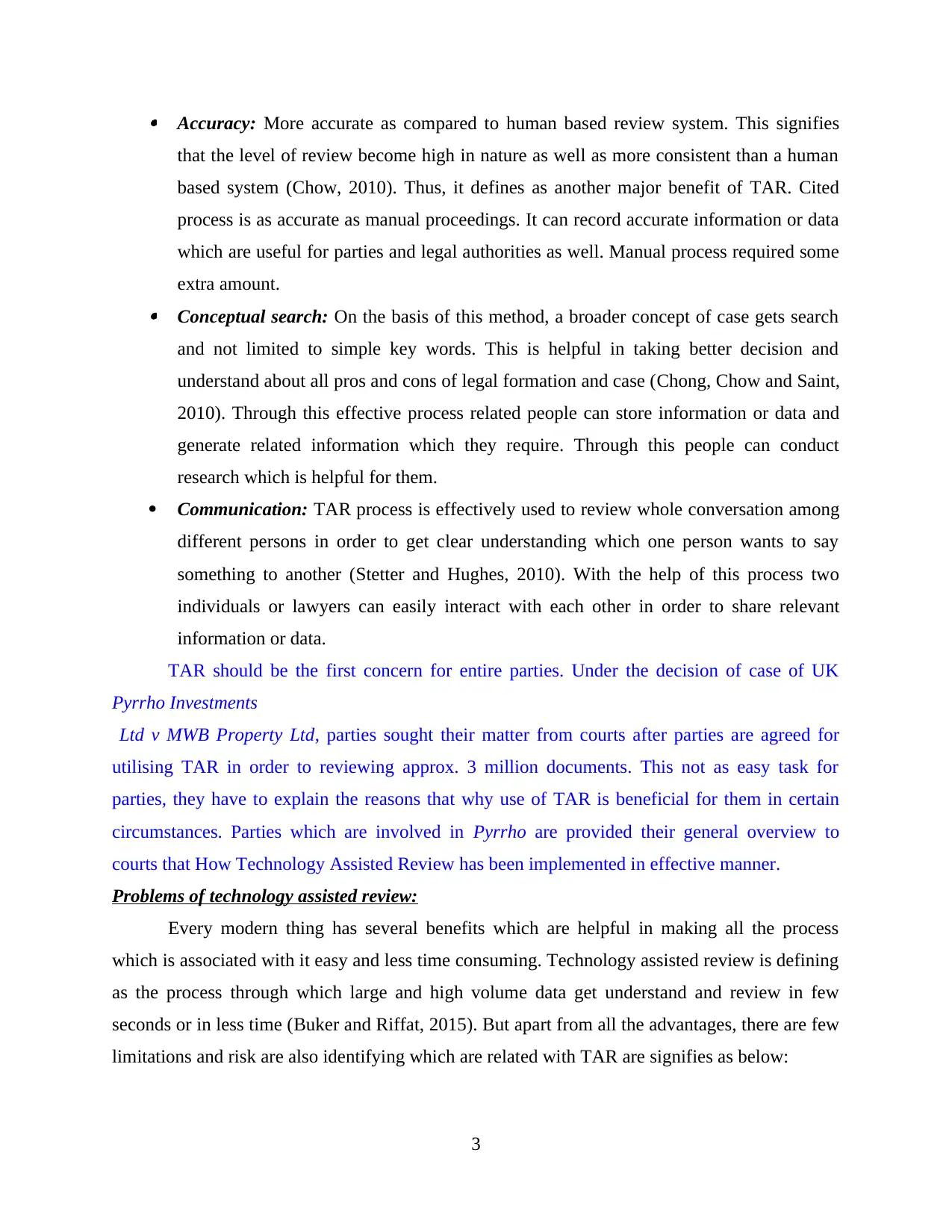
Accuracy: More accurate as compared to human based review system. This signifies
that the level of review become high in nature as well as more consistent than a human
based system (Chow, 2010). Thus, it defines as another major benefit of TAR. Cited
process is as accurate as manual proceedings. It can record accurate information or data
which are useful for parties and legal authorities as well. Manual process required some
extra amount. Conceptual search: On the basis of this method, a broader concept of case gets search
and not limited to simple key words. This is helpful in taking better decision and
understand about all pros and cons of legal formation and case (Chong, Chow and Saint,
2010). Through this effective process related people can store information or data and
generate related information which they require. Through this people can conduct
research which is helpful for them.
Communication: TAR process is effectively used to review whole conversation among
different persons in order to get clear understanding which one person wants to say
something to another (Stetter and Hughes, 2010). With the help of this process two
individuals or lawyers can easily interact with each other in order to share relevant
information or data.
TAR should be the first concern for entire parties. Under the decision of case of UK
Pyrrho Investments
Ltd v MWB Property Ltd, parties sought their matter from courts after parties are agreed for
utilising TAR in order to reviewing approx. 3 million documents. This not as easy task for
parties, they have to explain the reasons that why use of TAR is beneficial for them in certain
circumstances. Parties which are involved in Pyrrho are provided their general overview to
courts that How Technology Assisted Review has been implemented in effective manner.
Problems of technology assisted review:
Every modern thing has several benefits which are helpful in making all the process
which is associated with it easy and less time consuming. Technology assisted review is defining
as the process through which large and high volume data get understand and review in few
seconds or in less time (Buker and Riffat, 2015). But apart from all the advantages, there are few
limitations and risk are also identifying which are related with TAR are signifies as below:
3
that the level of review become high in nature as well as more consistent than a human
based system (Chow, 2010). Thus, it defines as another major benefit of TAR. Cited
process is as accurate as manual proceedings. It can record accurate information or data
which are useful for parties and legal authorities as well. Manual process required some
extra amount. Conceptual search: On the basis of this method, a broader concept of case gets search
and not limited to simple key words. This is helpful in taking better decision and
understand about all pros and cons of legal formation and case (Chong, Chow and Saint,
2010). Through this effective process related people can store information or data and
generate related information which they require. Through this people can conduct
research which is helpful for them.
Communication: TAR process is effectively used to review whole conversation among
different persons in order to get clear understanding which one person wants to say
something to another (Stetter and Hughes, 2010). With the help of this process two
individuals or lawyers can easily interact with each other in order to share relevant
information or data.
TAR should be the first concern for entire parties. Under the decision of case of UK
Pyrrho Investments
Ltd v MWB Property Ltd, parties sought their matter from courts after parties are agreed for
utilising TAR in order to reviewing approx. 3 million documents. This not as easy task for
parties, they have to explain the reasons that why use of TAR is beneficial for them in certain
circumstances. Parties which are involved in Pyrrho are provided their general overview to
courts that How Technology Assisted Review has been implemented in effective manner.
Problems of technology assisted review:
Every modern thing has several benefits which are helpful in making all the process
which is associated with it easy and less time consuming. Technology assisted review is defining
as the process through which large and high volume data get understand and review in few
seconds or in less time (Buker and Riffat, 2015). But apart from all the advantages, there are few
limitations and risk are also identifying which are related with TAR are signifies as below:
3
⊘ This is a preview!⊘
Do you want full access?
Subscribe today to unlock all pages.

Trusted by 1+ million students worldwide
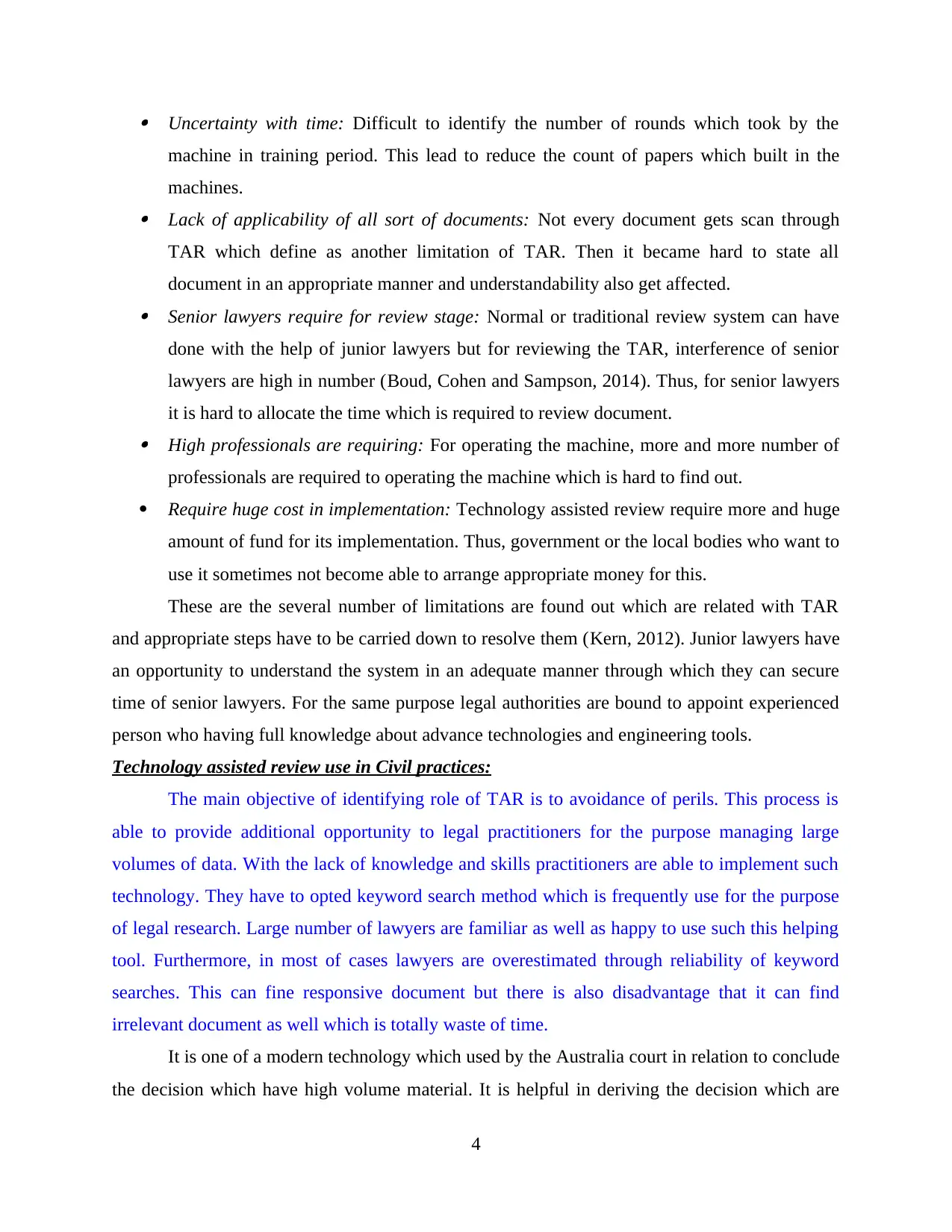
Uncertainty with time: Difficult to identify the number of rounds which took by the
machine in training period. This lead to reduce the count of papers which built in the
machines. Lack of applicability of all sort of documents: Not every document gets scan through
TAR which define as another limitation of TAR. Then it became hard to state all
document in an appropriate manner and understandability also get affected. Senior lawyers require for review stage: Normal or traditional review system can have
done with the help of junior lawyers but for reviewing the TAR, interference of senior
lawyers are high in number (Boud, Cohen and Sampson, 2014). Thus, for senior lawyers
it is hard to allocate the time which is required to review document. High professionals are requiring: For operating the machine, more and more number of
professionals are required to operating the machine which is hard to find out.
Require huge cost in implementation: Technology assisted review require more and huge
amount of fund for its implementation. Thus, government or the local bodies who want to
use it sometimes not become able to arrange appropriate money for this.
These are the several number of limitations are found out which are related with TAR
and appropriate steps have to be carried down to resolve them (Kern, 2012). Junior lawyers have
an opportunity to understand the system in an adequate manner through which they can secure
time of senior lawyers. For the same purpose legal authorities are bound to appoint experienced
person who having full knowledge about advance technologies and engineering tools.
Technology assisted review use in Civil practices:
The main objective of identifying role of TAR is to avoidance of perils. This process is
able to provide additional opportunity to legal practitioners for the purpose managing large
volumes of data. With the lack of knowledge and skills practitioners are able to implement such
technology. They have to opted keyword search method which is frequently use for the purpose
of legal research. Large number of lawyers are familiar as well as happy to use such this helping
tool. Furthermore, in most of cases lawyers are overestimated through reliability of keyword
searches. This can fine responsive document but there is also disadvantage that it can find
irrelevant document as well which is totally waste of time.
It is one of a modern technology which used by the Australia court in relation to conclude
the decision which have high volume material. It is helpful in deriving the decision which are
4
machine in training period. This lead to reduce the count of papers which built in the
machines. Lack of applicability of all sort of documents: Not every document gets scan through
TAR which define as another limitation of TAR. Then it became hard to state all
document in an appropriate manner and understandability also get affected. Senior lawyers require for review stage: Normal or traditional review system can have
done with the help of junior lawyers but for reviewing the TAR, interference of senior
lawyers are high in number (Boud, Cohen and Sampson, 2014). Thus, for senior lawyers
it is hard to allocate the time which is required to review document. High professionals are requiring: For operating the machine, more and more number of
professionals are required to operating the machine which is hard to find out.
Require huge cost in implementation: Technology assisted review require more and huge
amount of fund for its implementation. Thus, government or the local bodies who want to
use it sometimes not become able to arrange appropriate money for this.
These are the several number of limitations are found out which are related with TAR
and appropriate steps have to be carried down to resolve them (Kern, 2012). Junior lawyers have
an opportunity to understand the system in an adequate manner through which they can secure
time of senior lawyers. For the same purpose legal authorities are bound to appoint experienced
person who having full knowledge about advance technologies and engineering tools.
Technology assisted review use in Civil practices:
The main objective of identifying role of TAR is to avoidance of perils. This process is
able to provide additional opportunity to legal practitioners for the purpose managing large
volumes of data. With the lack of knowledge and skills practitioners are able to implement such
technology. They have to opted keyword search method which is frequently use for the purpose
of legal research. Large number of lawyers are familiar as well as happy to use such this helping
tool. Furthermore, in most of cases lawyers are overestimated through reliability of keyword
searches. This can fine responsive document but there is also disadvantage that it can find
irrelevant document as well which is totally waste of time.
It is one of a modern technology which used by the Australia court in relation to conclude
the decision which have high volume material. It is helpful in deriving the decision which are
4
Paraphrase This Document
Need a fresh take? Get an instant paraphrase of this document with our AI Paraphraser
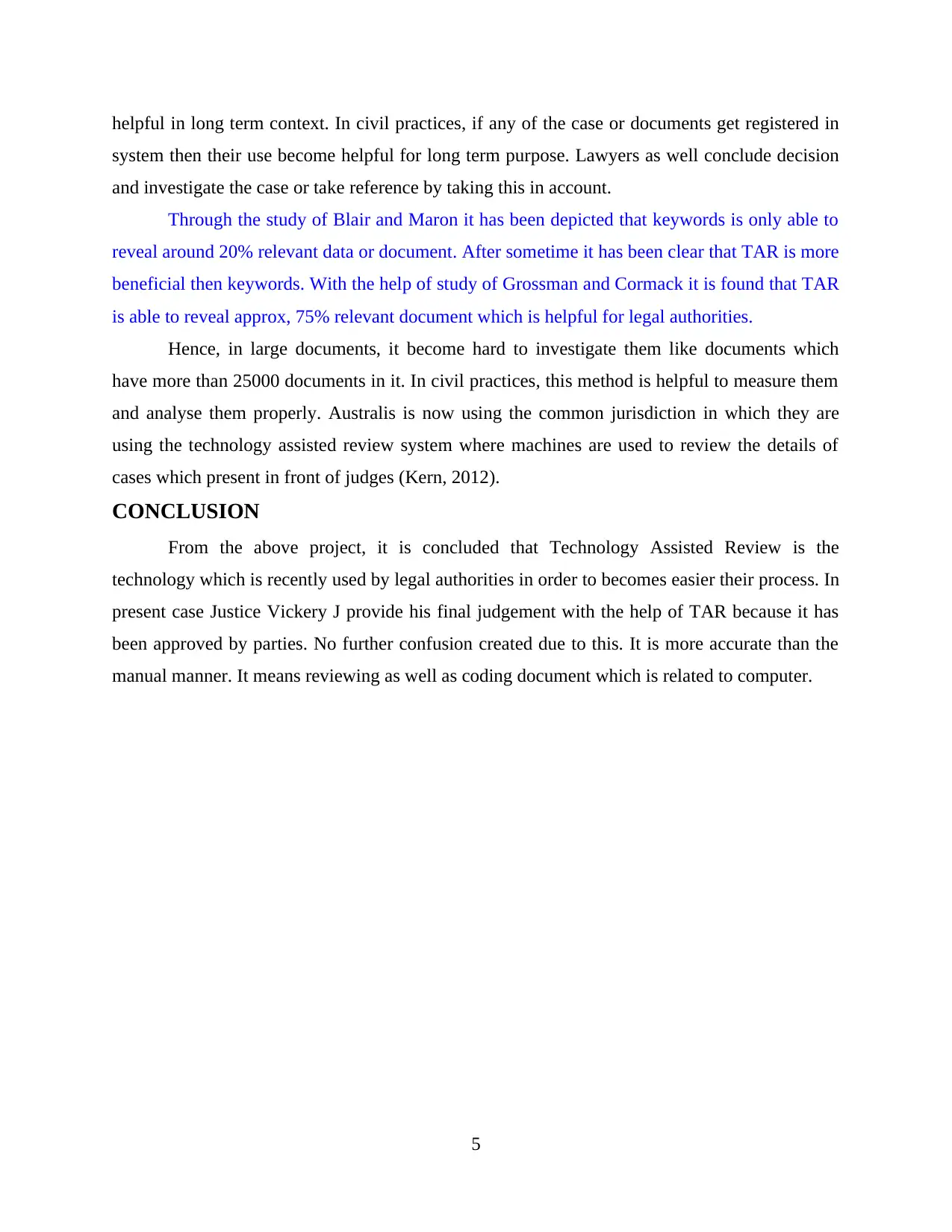
helpful in long term context. In civil practices, if any of the case or documents get registered in
system then their use become helpful for long term purpose. Lawyers as well conclude decision
and investigate the case or take reference by taking this in account.
Through the study of Blair and Maron it has been depicted that keywords is only able to
reveal around 20% relevant data or document. After sometime it has been clear that TAR is more
beneficial then keywords. With the help of study of Grossman and Cormack it is found that TAR
is able to reveal approx, 75% relevant document which is helpful for legal authorities.
Hence, in large documents, it become hard to investigate them like documents which
have more than 25000 documents in it. In civil practices, this method is helpful to measure them
and analyse them properly. Australis is now using the common jurisdiction in which they are
using the technology assisted review system where machines are used to review the details of
cases which present in front of judges (Kern, 2012).
CONCLUSION
From the above project, it is concluded that Technology Assisted Review is the
technology which is recently used by legal authorities in order to becomes easier their process. In
present case Justice Vickery J provide his final judgement with the help of TAR because it has
been approved by parties. No further confusion created due to this. It is more accurate than the
manual manner. It means reviewing as well as coding document which is related to computer.
5
system then their use become helpful for long term purpose. Lawyers as well conclude decision
and investigate the case or take reference by taking this in account.
Through the study of Blair and Maron it has been depicted that keywords is only able to
reveal around 20% relevant data or document. After sometime it has been clear that TAR is more
beneficial then keywords. With the help of study of Grossman and Cormack it is found that TAR
is able to reveal approx, 75% relevant document which is helpful for legal authorities.
Hence, in large documents, it become hard to investigate them like documents which
have more than 25000 documents in it. In civil practices, this method is helpful to measure them
and analyse them properly. Australis is now using the common jurisdiction in which they are
using the technology assisted review system where machines are used to review the details of
cases which present in front of judges (Kern, 2012).
CONCLUSION
From the above project, it is concluded that Technology Assisted Review is the
technology which is recently used by legal authorities in order to becomes easier their process. In
present case Justice Vickery J provide his final judgement with the help of TAR because it has
been approved by parties. No further confusion created due to this. It is more accurate than the
manual manner. It means reviewing as well as coding document which is related to computer.
5
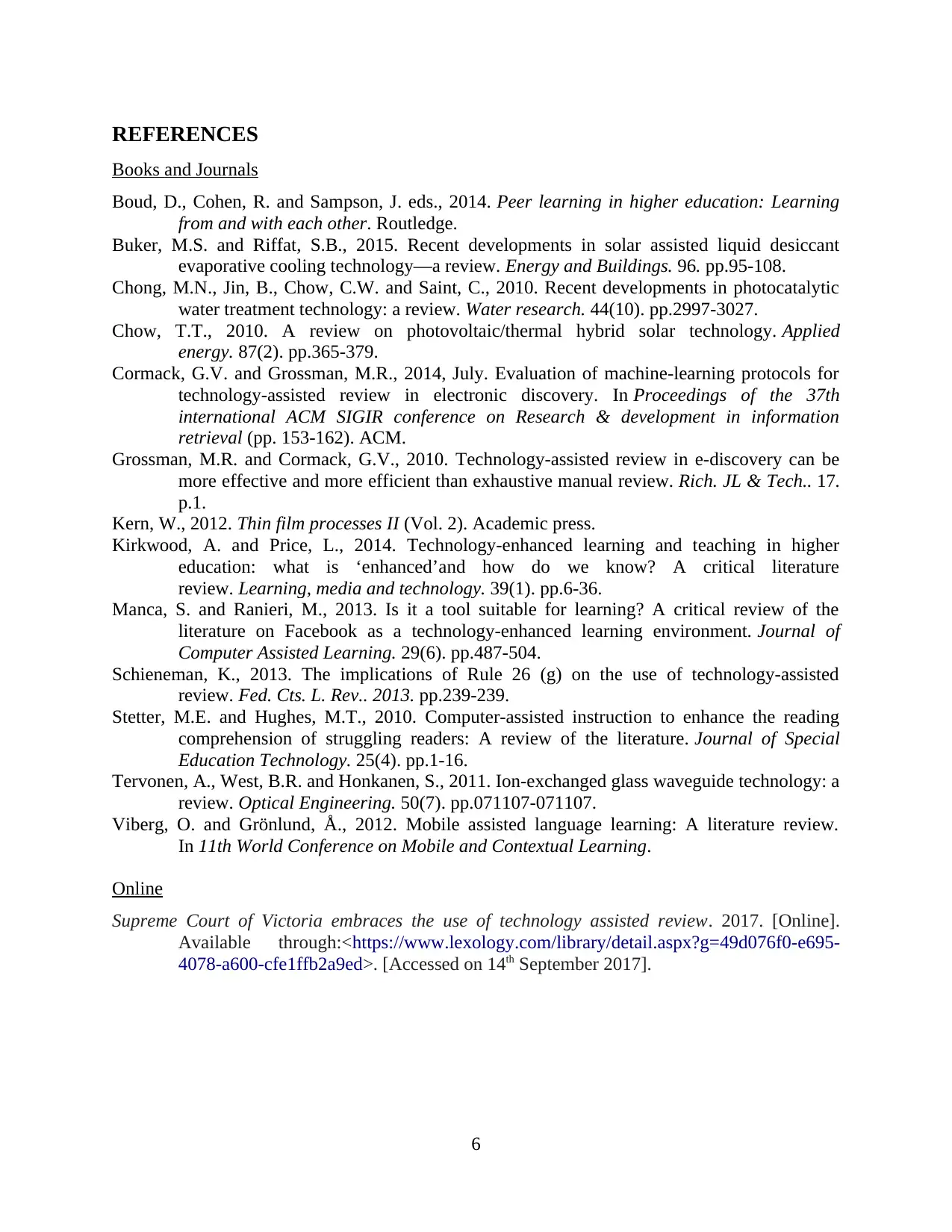
REFERENCES
Books and Journals
Boud, D., Cohen, R. and Sampson, J. eds., 2014. Peer learning in higher education: Learning
from and with each other. Routledge.
Buker, M.S. and Riffat, S.B., 2015. Recent developments in solar assisted liquid desiccant
evaporative cooling technology—a review. Energy and Buildings. 96. pp.95-108.
Chong, M.N., Jin, B., Chow, C.W. and Saint, C., 2010. Recent developments in photocatalytic
water treatment technology: a review. Water research. 44(10). pp.2997-3027.
Chow, T.T., 2010. A review on photovoltaic/thermal hybrid solar technology. Applied
energy. 87(2). pp.365-379.
Cormack, G.V. and Grossman, M.R., 2014, July. Evaluation of machine-learning protocols for
technology-assisted review in electronic discovery. In Proceedings of the 37th
international ACM SIGIR conference on Research & development in information
retrieval (pp. 153-162). ACM.
Grossman, M.R. and Cormack, G.V., 2010. Technology-assisted review in e-discovery can be
more effective and more efficient than exhaustive manual review. Rich. JL & Tech.. 17.
p.1.
Kern, W., 2012. Thin film processes II (Vol. 2). Academic press.
Kirkwood, A. and Price, L., 2014. Technology-enhanced learning and teaching in higher
education: what is ‘enhanced’and how do we know? A critical literature
review. Learning, media and technology. 39(1). pp.6-36.
Manca, S. and Ranieri, M., 2013. Is it a tool suitable for learning? A critical review of the
literature on Facebook as a technology‐enhanced learning environment. Journal of
Computer Assisted Learning. 29(6). pp.487-504.
Schieneman, K., 2013. The implications of Rule 26 (g) on the use of technology-assisted
review. Fed. Cts. L. Rev.. 2013. pp.239-239.
Stetter, M.E. and Hughes, M.T., 2010. Computer-assisted instruction to enhance the reading
comprehension of struggling readers: A review of the literature. Journal of Special
Education Technology. 25(4). pp.1-16.
Tervonen, A., West, B.R. and Honkanen, S., 2011. Ion-exchanged glass waveguide technology: a
review. Optical Engineering. 50(7). pp.071107-071107.
Viberg, O. and Grönlund, Å., 2012. Mobile assisted language learning: A literature review.
In 11th World Conference on Mobile and Contextual Learning.
Online
Supreme Court of Victoria embraces the use of technology assisted review. 2017. [Online].
Available through:<https://www.lexology.com/library/detail.aspx?g=49d076f0-e695-
4078-a600-cfe1ffb2a9ed>. [Accessed on 14th September 2017].
6
Books and Journals
Boud, D., Cohen, R. and Sampson, J. eds., 2014. Peer learning in higher education: Learning
from and with each other. Routledge.
Buker, M.S. and Riffat, S.B., 2015. Recent developments in solar assisted liquid desiccant
evaporative cooling technology—a review. Energy and Buildings. 96. pp.95-108.
Chong, M.N., Jin, B., Chow, C.W. and Saint, C., 2010. Recent developments in photocatalytic
water treatment technology: a review. Water research. 44(10). pp.2997-3027.
Chow, T.T., 2010. A review on photovoltaic/thermal hybrid solar technology. Applied
energy. 87(2). pp.365-379.
Cormack, G.V. and Grossman, M.R., 2014, July. Evaluation of machine-learning protocols for
technology-assisted review in electronic discovery. In Proceedings of the 37th
international ACM SIGIR conference on Research & development in information
retrieval (pp. 153-162). ACM.
Grossman, M.R. and Cormack, G.V., 2010. Technology-assisted review in e-discovery can be
more effective and more efficient than exhaustive manual review. Rich. JL & Tech.. 17.
p.1.
Kern, W., 2012. Thin film processes II (Vol. 2). Academic press.
Kirkwood, A. and Price, L., 2014. Technology-enhanced learning and teaching in higher
education: what is ‘enhanced’and how do we know? A critical literature
review. Learning, media and technology. 39(1). pp.6-36.
Manca, S. and Ranieri, M., 2013. Is it a tool suitable for learning? A critical review of the
literature on Facebook as a technology‐enhanced learning environment. Journal of
Computer Assisted Learning. 29(6). pp.487-504.
Schieneman, K., 2013. The implications of Rule 26 (g) on the use of technology-assisted
review. Fed. Cts. L. Rev.. 2013. pp.239-239.
Stetter, M.E. and Hughes, M.T., 2010. Computer-assisted instruction to enhance the reading
comprehension of struggling readers: A review of the literature. Journal of Special
Education Technology. 25(4). pp.1-16.
Tervonen, A., West, B.R. and Honkanen, S., 2011. Ion-exchanged glass waveguide technology: a
review. Optical Engineering. 50(7). pp.071107-071107.
Viberg, O. and Grönlund, Å., 2012. Mobile assisted language learning: A literature review.
In 11th World Conference on Mobile and Contextual Learning.
Online
Supreme Court of Victoria embraces the use of technology assisted review. 2017. [Online].
Available through:<https://www.lexology.com/library/detail.aspx?g=49d076f0-e695-
4078-a600-cfe1ffb2a9ed>. [Accessed on 14th September 2017].
6
⊘ This is a preview!⊘
Do you want full access?
Subscribe today to unlock all pages.

Trusted by 1+ million students worldwide
1 out of 9
Your All-in-One AI-Powered Toolkit for Academic Success.
+13062052269
info@desklib.com
Available 24*7 on WhatsApp / Email
![[object Object]](/_next/static/media/star-bottom.7253800d.svg)
Unlock your academic potential
Copyright © 2020–2025 A2Z Services. All Rights Reserved. Developed and managed by ZUCOL.
